|
|
|
2nd Battalion, Grenadier Guards
| Want to know more about 2nd Battalion, Grenadier Guards? There are:51 items tagged 2nd Battalion, Grenadier Guards available in our Library There are:51 items tagged 2nd Battalion, Grenadier Guards available in our Library 
These include information on officers, regimental histories, letters, diary entries, personal accounts and information about actions during the Great War.
|
|
Those known to have served with2nd Battalion, Grenadier Guards during the Great War 1914-1918. - Appleton Frederick William Henry. Pte.
- Bradon John. Grdsm. (d.12th Oct 1917 )
- Brearley George.
- Brennan Thomas. L/Cpl. (d.4th Nov 1914)
- Brooks Walter Ainger. Pte. (d.31st July 1917)
- Cecil MC. William Amherst . Capt (d.16th Sep 1914)
- Crundwell George. Pte. (d.25th Sep 1916)
- Cunliffe Thomas. Pte. (d.23rd Oct 1915)
- Daniels Daniel. Guardsman. (d.1st Sep 1914)
- Dooley Joseph. Pte
- Drayton Percey Horace. Gdsm. (d.21st Dec 1915)
- Green Thomas James. L/Sgt. (d.24th Dec 1914)
- Hatton Christopher Geoffrey. Sgt. (d.6th Jan 1918)
- Holmes VC. William Edgar. Pte. (d.9th Oct 1918)
- Leatham John. Pte. (d.12th March 1915)
- Moore Frank. Pte (d.25th Sep 1916)
- Moulson Walter Henry. Gdsm. (d.16th Sep 1914)
- Robinson Alfred Sydney. Gdsm. (d.29th Apr 1916)
- Rutherford George. Pte (d.19th Sep 1918)
- Simpson Josiah. Pte.
- Stockley Richard. L/Cpl. (d.25th Sep 1916)
- Whappshott John William. Pte.
- Zaleski Joseph. Pte.
All names on this list have been submitted by relatives, friends, neighbours and others who wish to remember them, if you have any names to add or any recollections or photos of those listed,
please Add a Name to this List
Records of 2nd Battalion, Grenadier Guards from other sources.
|
|
The Wartime Memories Project is the original WW1 and WW2 commemoration website.

- 1st of September 2024 marks 25 years since the launch of the Wartime Memories Project. Thanks to everyone who has supported us over this time.
|
Want to find out more about your relative's service? Want to know what life was like during the Great War? Our
Library contains many many diary entries, personal letters and other documents, most transcribed into plain text.
|
Looking for help with Family History Research?
Please see Family History FAQ's
Please note: We are unable to provide individual research.
|
|
Can you help?
The free to access section of The Wartime Memories Project website is run by volunteers and funded by donations from our visitors.
If the information here has been helpful or you have enjoyed reaching the stories please conside making a donation, no matter how small, would be much appreciated, annually we need to raise enough funds to pay for our web hosting or this site will vanish from the web.
If you enjoy this site
please consider making a donation.
Announcements
- 26th Mar 2025
Please note we currently have a massive backlog of submitted material, our volunteers are working through this as quickly as possible and all names, stories and photos will be added to the site. If you have already submitted a story to the site and your UID reference number is higher than
265607 your submission is still in the queue, please do not resubmit.
Wanted: Digital copies of Group photographs, Scrapbooks, Autograph books, photo albums, newspaper clippings, letters, postcards and ephemera relating to the Great War. If you have any unwanted
photographs, documents or items from the First or Second World War, please do not destroy them. The Wartime Memories Project will give them a good home and ensure that they are used for educational purposes. Please get in touch for the postal address, do not sent them to our PO Box as packages are not accepted.
|
World War 1 One ww1 wwII greatwar great battalion regiment artillery
Did you know? We also have a section on World War Two. and a
Timecapsule to preserve stories from other conflicts for future generations.
|
|
|
Pte. Josiah Simpson 2nd Battalion Grenadiers Guards 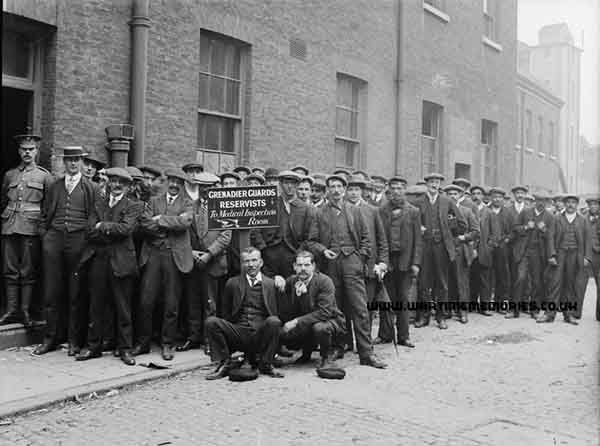 Josiah Simpson married my Grandmother in the mid 1950's after the death of my Natural Grandfather. Jo as he was always known to the family (except by me as a 6 year old boy, I called him Uncle Jo), had been a professional soldier who joined the 2nd Battalion Grenadier Guards in 1909.
Jo passed away soon after marrying my maternal Grandmother and whenever I visited with my Mother I would try and draw Uncle Jo out about his Great War experiences, as this was endlessly fascinating to a young boy as you can imagine! Like many old soldiers Jo was very reticent about his experiences and I was not old enough to understand how to ask the right questions, and now of course it is far too late. I actually learnt more about Jo's war experiences from my Grandmother who told me amongst other things of the nightmares he still suffered from. She also told me that he had been wounded in action three times (discharged with a severe head injury involving delicate surgery and the fitting of a stainless steel plate in his skull). She also said that Jo had been mentioned in despatches and had received a letter of thanks from the King of which he was immense proud.
I have been able to glean quite a bit of his history, but have now reached a blank, and in the hope that anyone might be able to help me I will tell you what I know:
Jo was born in sometime in 1888 and enlisted in the 2nd Battalion Grenadier Guards 25th February 1909 (aged 21) his army Service Number was 14275. At that time the Guards' regiments recruited men for three years with the colours and nine years on the reserve to be recalled at the outbreak of a general war. So I imagine that Jo would have transferred to the reserve around early 1912. In August 1914 he would presumably have been recalled to the colours at the age of 24 and there is a well known photograph taken outside Wellington Barracks in 1914 showing a queuing line of Grenadier Guard reservists reporting for duty with the colours.
I believe that I can recognise Uncle Jo in that photograph about halfway along the line of queuing Grenadier reservists. Jo was very tall and stood out in any group of which he was part. Even in later life he never lost his soldierly bearing, you would instantly recognise the old soldier from his bearing and dignity.
So much for the facts as I know them, what follows now is pure conjecture on my part.
Consulting the excellent book 'Fifteen Rounds A Minute' edited from the diaries of Major M A Jeffreys and others by J.M. Craster, I learned that Major Jeffreys (acting C/O 2nd Battalion GG) diary entry for Sunday 19th September 1914 records a draft arriving from England comprising the new C/O Colonel Wilfred Smith and several other officers and men during the First Battle of Aisne.
This fits rather well with Jo's medal sheet qualifying date of 17th September 1914, allowing for a couple of days to travel from Havre.
I also read from the same source that the 2nd Battalion's MG Officer (in command of the battalion's two MGs) Captain William Amherst Cecil M.C. M.I.D had been killed in action 16 September 1914 and other casualties in the MG section had occurred on the same date.
I now believe that Jo on arrival in the draft led by his C/O was assigned to one of the two M/G sections to make up the complement and therefore his Company Commander was 'Stag' Cecil's replacement who was 2nd Lieut. Carleton Wyndham Tufnell who had taken over command of the two guns on the death of Cecil.
Now Jo told me a tale in which his Company Commander was shot in the head and through the eye of the binoculars he was using to reconnoitre the German positions from a forward position, and in the same moment Jo himself was wounded for the first time. Believing the officer to be still alive and whilst under fire Jo dragged his body back to their own positions where he discovered that the officer had been instantly killed. If this officer was Tufnell then this must have been on November 6th 1914 as this is the date he was KIA. I have read that Lieut. Tufnell was shot during a reconnaissance looking for a good position for the M/Gs. I would have expected this officer would have carried and used binoculars whilst so engaged.
Referring again to 'Fifteen Rounds a Minute' I find the following
"Wilfred sent Congleton and his platoon of No 3 and Tufnell with his machine-gun section with orders to act against the flank of the Germans pushing through the gap. Congleton and his platoon went forward with the cavalry, but poor Tufnell was shot through the throat and died soon afterwards. He was a first rate officer and is a great loss. At the first alarm I had posted Tufnell with one machine gun on the Brown Road to guard a ride through the wood, across which the Germans would have had to come to get behind my line of trenches. I also sent Congleton with one platoon to stop the Germans getting through the gap on my right rear. For some reason, that I have never been able to get an explanation of, Tufnell took his machine-gun with Congleton's platoon.
I believe the machine-gun had one good target, but Tufnell was unfortunately hit at this time and I never did find out exactly what did occur."
Note that the account has poor Tufnell shot through the throat and not as Jo describes through the eye, so maybe my conjecture falls down at this point - maybe.
It does seem clear that Jo served for nearly 3 years from 17th September 1914 when he arrives in France until 6th July 1917 when he was discharged and awarded the silver war badge, which incidentally he wore in his jacket lapel every day until he died in the mid 1950's.
I imagine that when the the 1st Gds Bde MG Coy was formed between 1st September and 19th September, 1915, Jo would have transferred to it and served consequently in actions that the 2nd Battalion were engaged in from September 1914 (Battle of the Aisne) until some time after the battle of Messines now with the 4th Battalion Guards Machine Gun Company.
If you have borne with this long winded story, for which I apologise, I now come to the mystery....
01) Did Josiah Simpson get a Mention in Despatches? My Grandmother certainly told me had, together with a letter from the King. Why is this not on his medal sheet if he was in fact awarded a MID. I should have thought nearly 3 years in the front line, wounded in action three times (the latter seriously), recovering an officer's body under fire whilst wounded himself should have merited a bit more that the the three 'gongs' that everyone else received.
02) What has happened to Jo's medals (he had a daughter Edna and a Grandson Gerald, both long deceased) maybe they were passed down, but do you think we could still trace them?
Anything you can help with I will be most grateful.
|
Pte. William Edgar Holmes VC. 2nd Btn. Grenadier Guards (d.9th Oct 1918) William Holmes was killed in action on the 9th of October 1918, aged 23 and is buried in Carnieres Communal Cemetery in France.
He was the son of Mrs. E. E. Holmes, of Didbrook, Winchcombe, Glos.
An extract from The London Gazette, No. 31082, dated 24th Dec., 1918, records the following:- "For most conspicuous bravery and devotion to duty at Cattenieres on the 9th Oct., 1918. Pte. Holmes carried in two men under the most intense fire, and, while he was attending to a third case, he was severely wounded. In spite of this, he continued to carry wounded, and was shortly afterwards again wounded, with fatal results. By his self-sacrifice and disregard of danger he was the means of saving the lives of several of his comrades."
|
Pte. Thomas Cunliffe 2nd Btn. Grenadier Guards (d.23rd Oct 1915) 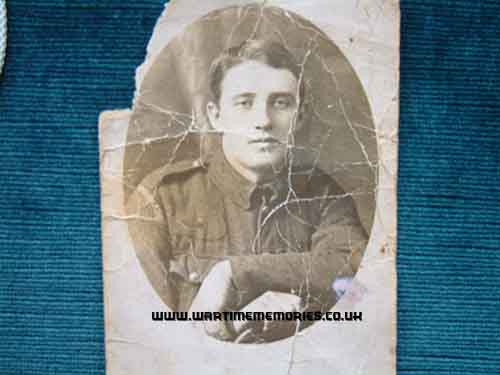 Thomas Cunliffe was my great uncle. He enlisted in the Grenadier Guards in June 1914 and then went to Caterham to undergo training. He joined with his best friend William Calderbank and sailed for France in January 1915 blissfully unaware that neither of them would see their home town again. They fought side by side at some notable and well documented engagements such as Hill 70 and the Battle of Loos and must have thought their luck would see them through. However this was not to be as after 9 months William was killed by a sniper and Thomas had the unenviable task of writing to Williams parents back in Wigan.
Dear Friends, I am sorry to inform you that your son got killed on the 7th. Poor lad he got hit in the head and his death was instantaneous. He has been in my mind ever since his death. A fellow came up the trenches and said your mate has gone under. I could hardly believe who it was at first and then he said Bill Calderbank. Well I felt as if Id been hit. I went to see him, poor fellow. He had a decent burial. The Catholic priest was there and read over his dead body. He had only just put his head up over the trench and he got hit by a sniper. Accept my deepest sympathy. All his chums hope you will accept their deepest sympathy.
The pathetic feature of this story is that the very next day after William was killed Thomas was wounded. A bomb exploded in the trench near him, blowing off one of his legs and damaging the other so severely that it later had to be amputated. He wrote to his parents, Joseph and Mary Cunliffe in Wigan,
Hope this finds you quite well as I am alive but hardly kicking His letter goes on to describe the events that led up to his injury and his hopes and expectations to be back in Wigan for Christmas. Unfortunately the story does not have a happy ending as on 23rd October Thomas died from his wounds. The lady superintendent at the hospital in Wimereux wrote to his parents telling them,
Your poor son got weaker and weaker in spite of all we tried to do for him. He will be buried here in the cemetery in Wimereux. It is a pretty place on a hillside and there are many flowers there in spring and summer. My assistant matron takes great interest in it and sees that it is nicely kept in order
Thomas will be remembered with pride and affection by our family.
|
L/Cpl. Thomas Brennan 2nd Btn. Grenadier Guards (d.4th Nov 1914) Thomas Brennan was my great uncle; my grandmother's brother. My mother said she had been told by her mother that he ran away with a friend (surname Comerford) to enlist, and that he lied about his age.
However, I have discovered his birth records and found he was aged 24 when he died. I have found out that he enlisted in Manchester.
He died in Flanders on 4th of November 1914 and his name is on the Menin Gate.
My mother told me that his friend returned to tell his mother of his death.
I know nothing else about him unfortunately. I want to make sure that his name is on every record and that he is never forgotten.
|
Pte. Joseph Zaleski 2nd Btn. Grenadier Guards Joseph Zaleski served with the 2nd Btn. Grenadier Guards
|
L/Sgt. Thomas James Green 2nd Btn. Grenadier Guards (d.24th Dec 1914) My great uncle, Thomas Green, was missing for years from my family history.
I found (by accident) a soldiers' enlistment poem which mentioned Sergeant Instructor Green, the father of Thomas Green of the Grenadier Guards who died on Christmas Eve 1914.
|
Pte. John William Whappshott 2nd Btn. Grenadier Guards My grandad, Jack Whappshott was lucky - he was injured at Ypres on the first day of the battle. He had his arm shattered but it meant that his time in the war was over. His brother was not so lucky. He died a few days before his 16th birthday.
|
George Brearley 2nd Btn. Grenadier Guards Former miner George Brearley was a regular soldier, with the 2nd Battalion, Grenadier Guards. He had landed in France on 13th August 1914 and after heavy fighting on 1st September a wounded comrade visited his brother to tell him that he had seen a shell burst, blowing him to smithereens.
As his family grieved, the reality was that George Brearley was alive, a prisoner of the Germans. Before they got to him he managed to scribble a note on a scrap of paper and placed it in a sealed bottle in the hope that someone would pass the message on to his family. If this paper is found will you please write to this address - Mrs. Davis, Star Inn, Bulwell, Notts., England and tell them George is well.
As unlikely as it sounds, the message was picked up a couple of weeks afterwards by a French civilian after the Germans had been forced to retreat from the area. Dutifully, he forwarded the message to Cissie Davis who had the covering letter translated by a French teacher at the Coventry Road School in Bulwell.
Despite this, George's family still doubted that he was alive and even when they received a postcard from him, it was thought that it was probably a forgery. However, the family was eventually convinced when they recognised him in a photograph of a working party in a German POW camp at Doeberitz, near Berlin. Somehow a newspaper published in Pennsylvania was sent to offices of the Dispatch. Staff there recognised George Brearley as the man, shovel in hand, digging a drainage ditch under the supervision of a German officer. Even then one family member did not believe that it was him.
The story of the sighting of him in the newspaper photograph is almost as unlikely as a message written in a bottle being discovered on a battlefield. It is true nevertheless.
George Brearley returned to Hucknall after the Armistice more than four years later.
|
Pte. Walter Ainger Brooks 2nd Btn. (d.31st July 1917) I recently found out while tracing family relatives that my great uncle, Walter Brooks, was killed in WW1 at Ypres. I knew of him, but had no idea he had been killed in WW1. My mother, his niece, was born the same month he died. I have been on many battlefield tours in recent years and visited the Menin Gate at Ypres a couple of years ago and am sad that I didn't know then that my great uncle was killed at Ypres and is mentioned on Panel 9 and 11 at the Menin Gate Memorial.
|
Pte. John Leatham 2nd Btn Yorkshire Regiment (d.12th March 1915) I believe John Leatham was killed during the Neuve Chapelle according to the date.
He is commemorated on Le Touret Memorial, France
|
Sgt. Christopher Geoffrey Hatton 2nd Battalion Grenadier Guards (d.6th Jan 1918) Christopher Geoffrey Hatton was my father's uncle. He was already in the Guards in 1911, married in 1916, and is buried in the Sunken Road Cemetary, Fampoux I. My father was named Geoffrey after him, but never met him, having been born 6 months after his death in action. And that, I'm afraid, is all I know.
|
Guardsman. Daniel Daniels 2nd Batt. D Coy, Grenadier Guards (d.1st Sep 1914) 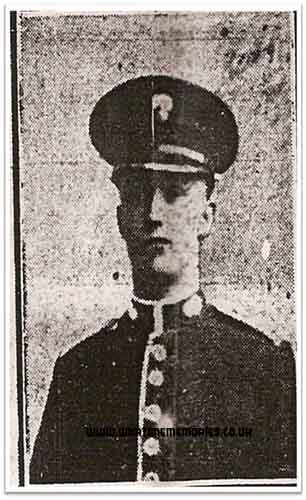 Danny Daniels, my great uncle, was born on the 20th November 1893 at No 3 Hot Lane, Burslem, son of Alfred and Annie Elizabeth Daniels. He was previously a miners wagoner and a 5th Batt. N. Staffords Territorial soldier, his enlistment with the Colours was in April 1913. He was shipped to France in August 1914 from Chelsea Barracks onboard the Cawdor Castle, leaving Southampton for Le Havre in France along with the 4th Guards Brigade was part of 1 Corps under Gen.Douglas Haig.
He then commenced the long march retreat from Mons seeing limited action even at Landrecies where D Coy 4th Btn were covering a bridge south of the town. Arriving at Villers Cotterets on the 31st August he was part of the rear guard action at the Rond dela Reine in the Foret de Retz that took place the following day. Along with his brother soldier Guardsmen he was killed either in the action to the west of the clearing with some of the Coldstream Guardsmen when the fighting in the dense undergrowth was very confusing or during the bayonet charge led by 2Lt Edward Cecil as reported in his excellent book 'Fifteen Rounds a Minute' by Major 'Ma' Jeffries.
Danny now lies in the Guards Grave along with ninety eight other fatalities suffered during the action, whilst others remain undiscovered to this day in the surrounding forest. On a recent visit in November 2014 we placed a wreath on the anniversary of his birthday and said a small prayer to his everlasting memory.
Sadly the date recorded on his gravestone is shown as the 20th September because this was when his death was reported back to 3rd echelon just after his body was recovered
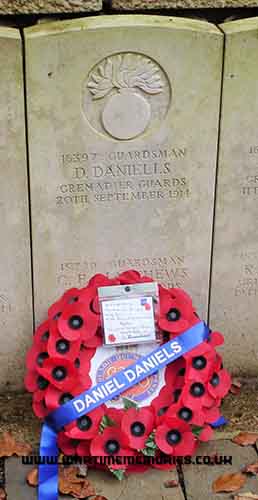 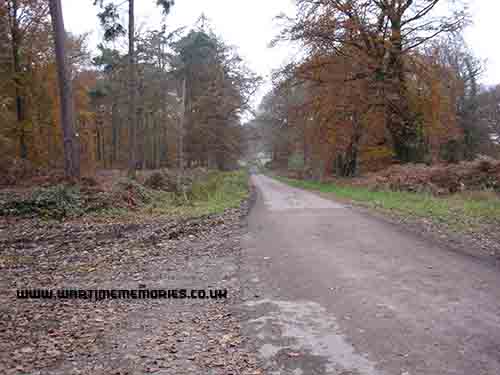 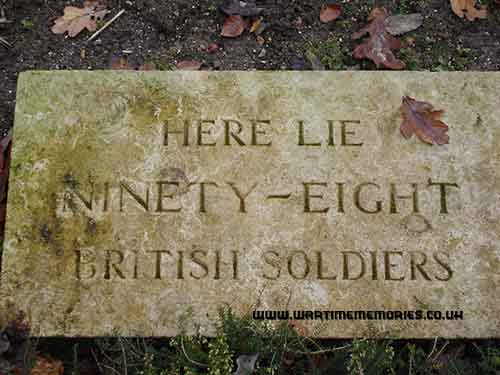 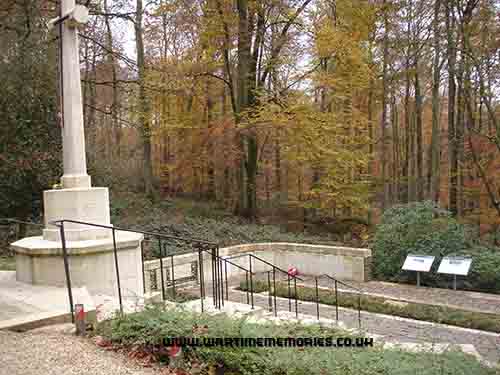
|
Pte. Frederick William Henry Appleton 2nd Btn. Grenadier Guards Frederick Appleton served with the 2nd Battalion, Grenadier Guards.
|
L/Cpl. Richard Stockley 2nd Btn. Grenadier Guards (d.25th Sep 1916) L/Cpl Richard Stockley was my grandmother's younger brother.
He served in the 2nd Battalion, Grenadier Guards in 1st and 4th Guards Brigade. He died at the age of 20 years on 25th September 1916 in the battle to capture Les Boeufs. He is commemorated in the Guards Cemetery of the same name. I followed in his footsteps many years later joining the Welsh Guards and also served in 4th Guards Armoured Brigade
|
Pte. George Crundwell 2nd Battalion Grenadier Guards (d.25th Sep 1916) My great uncle George Crundwell fought and died on the day the village of Lesbeoufs was taken by the Guards divisions. He is buried at Guards Cemetery outside Lesbeouf. His elder brother, Fred, also in the 2nd Battalion fell in 1918
|
Grdsm. John Bradon 2nd Btn. Grenadier Guards (d.12th Oct 1917 ) John Bradon was born in Dublin and enlisted in Manchester. He served with the Gtrenadier Guards 2nd Battalion and was killed in action in October 1917.
|
Pte Frank Moore 1st Bn Grenadier Guards (d.25th Sep 1916) Only found out that I had a member of my family in the Great War when my grandad died. In his brief case was a cut out from a newspaper saying that Pte Frank Moore had been killed in action in France in 1916. Also found postcards sent to and from him that my great nan kept.
|
Capt William Amherst Cecil MC. 2nd Bn. Grenadier Guards (d.16th Sep 1914) Capt William Cecil was 28 years old and died apparently after being shot by a German sniper during the First Battle of the Aisne, one of the opening clashes of the conflict. Capt Cecil, of the 2nd Bn Grenadier Guards, a career soldier, had been sent to France just eight days after the outbreak of war and was part of the army that found itself in pursuit of retreating German forces near the Aisne river, in north-eastern France.
When the Germans turned to face them, the two sides engaged in a bloody confrontation. With neither side able to dislodge the other, both began to dig themselves into defensive positions, beginning the strategic stalemate that was to endure for four years. Capt Cecil, who would have become Baron Cecil of Hackney if he had lived, was killed on the 16th of Sept 1914, two days after the first order to entrench was made.
Posthumously, his courage was recognised, he was decorated with the Military Cross, the third-highest honour available to officers, and was promoted from lieutenant to captain. One memoir notes that he was among the first aristocratic casualties of the war.
|
Gdsm. Percey Horace Drayton 2nd Btn. Grenadier Guards (d.21st Dec 1915) Percey Horace Drayton a horse keeper from Smith End, Barley, he enlisted at Walthamstow on the 16th of December 1902 as a gunner with the Household Cavalry and Royal Artillery. Occasionally reprimanded for being out after curfew in Canada (8 days confined to barracks) and for causing a disturbance in a girl's school at night in Allahabad (14 days detention), admonished for drunkenness twice in 1903 and hospitalised for diphtheria and Malaria 1907 and 08. After completing his colour service he transferred to the Reserve before reenlisting as a Guardsman in the 2nd Battalion Grenadier Guards. He went briefly AWOL 14th Sept 1914 after being wounded on the Western Front. He died of his wounds, 21st December 1915 having been transferred back to England two weeks earlier.
|
Gdsm. Walter Henry Moulson 2nd Btn. Grenadier Guards (d.16th Sep 1914) Walter Henry Moulson was my great uncle. I believe that he joined the Grenadier Guards in 1911 enlisting at Chester. He was born in Worthenbury in Ceshire in 1883 and whilst a young child his family moved to Sareshill near Wolverhampton. Walter was the eldest child of seven. His father, a groom, died at the young age of 41 years in 1899 when Walter was just 16. His mother remarried in 1901 but this happiness was short lived as she died in childbirth aged 36 years in 1902 leaving Walter to be the head of the family. He was a tile carrier for several years until his siblings grew up and when they were all settled he joined the army. His service number was 12390 and when World War One began he travelled from Chelsea to Le Havre between 4-15th August 1914 where, as a member of the British Expeditionary Force he was one of the first soldiers to go to France serving with the 2nd Battalion of the Grenadier Guards. It is believed that he fought at the Battle of Mons and then the Battle of the Marne. He was killed in action on 16th September 1914 believed during the 1st Battle of the Aisne. I have no further information of the incidents leading up to his death or how he died but i suspect that as it was the early part of trench warfare he may have been shot whilst digging a trench or hit by a morter shell. Unfortunately, I have no photograph of my great Uncle Walter who was my paternal grandmother's brother. He is remembered with honour by myself and at the ancient church of St Marys in Shareshill village where there is an inscription to the fallen residents of the village during the great war.
|
Recomended Reading.Available at discounted prices.
|
|
|


Site Home
Great War Home
Search
Add Stories
Library
Help & FAQs
Allied Army
Day by Day
RFC & RAF
Prisoners of War
War at Sea
Training for War
The Battles
Those Who Served
Hospitals
Civilian Service
Women at War
The War Effort
Central Powers Army
Central Powers Navy
Imperial Air Service
Library
World War Two
Add Stories & Photos
Time Capsule
Help & FAQs
Glossary
Volunteering
News
Events
Contact us
Great War Books
About
There are:51 items tagged 2nd Battalion, Grenadier Guards available in our Library
